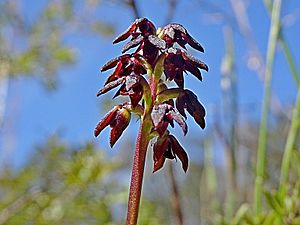Spring midge orchid facts for kids
Quick facts for kids Spring midge orchid |
|
|---|---|
 |
|
| Conservation status | |
| Scientific classification | |
| Genus: |
Genoplesium
|
| Species: |
vernale
|
| Synonyms | |
|
|
The Spring midge orchid (Genoplesium vernale), also called the East Lynne midge orchid, is a small and unique plant. It is a type of orchid that grows only in a small area on the south coast of New South Wales, Australia. This orchid has a single thin leaf. It can grow up to twenty-five dark purplish-black flowers. These flowers have tiny, special hairs on their parts.
Contents
What Does the Spring Midge Orchid Look Like?
The Spring midge orchid is a perennial plant. This means it lives for more than two years. It is also a deciduous plant, so it loses its leaves at certain times. It grows from an underground tuber, which is like a small storage root.
Its single leaf is dark green and about 100–180 mm (4–7 in) long. The base of the leaf is reddish. The part of the leaf that stands freely is about 10–15 mm (0.4–0.6 in) long.
The Flowers
Between ten and twenty-five dark purplish-black flowers grow close together on a stem. This stem is about 20–40 mm (0.8–2 in) long. The whole plant can reach a height of 150–250 mm (6–10 in).
The flowers hang downwards. Each flower is about 6 mm (0.2 in) long and 4.5 mm (0.2 in) wide. Like other orchids in its group, its flowers are upside down. This means the labellum (a special lip-like petal) is above the column (the central part of the flower), not below it.
- The dorsal sepal (the top part of the flower) is egg-shaped. It is about 3.5 mm (0.1 in) long and 2.5 mm (0.1 in) wide. It has a sharp tip and tiny hairs on its edges.
- The lateral sepals (the side parts) are narrow and about 4.5 mm (0.2 in) long. They have a small hump at their base and tiny hairs on their edges.
- The petals are narrow and about 3 mm (0.1 in) long. They also have sharp tips and tiny hairs.
- The labellum is the orchid's special lip. It is about 3 mm (0.1 in) long and 1.5 mm (0.06 in) wide. It is thick and fleshy, with tiny hairs on its edges.
- There is a dark purple or brownish-black callus (a raised, fleshy part) in the center of the labellum. It reaches almost to the tip.
This orchid usually flowers between September and December.
How Did It Get Its Name?
The Spring midge orchid was first officially described in 2001. This was done by a botanist named David Jones. The description was published in a magazine called The Orchadian.
In 2002, David Jones and another botanist, Mark Clements, changed its name to Corunastylis vernalis. The word vernale in its name is a Latin word. It means "spring," which is why it's called the Spring midge orchid.
Where Does This Orchid Live?
The Spring midge orchid grows in a type of forest that has many shrubs. You can find it in the area between Jervis Bay and Mogo in New South Wales.
Protecting the Spring Midge Orchid
The Spring midge orchid is only found in a small forest area. This area is about 12 km (7 mi) wide. A study in 2000 found about 450 of these plants. However, there are likely more, as not all suitable places have been checked.
This orchid faces several dangers:
- Land clearing: Forests where it grows are sometimes cleared for other uses.
- Forestry operations: Activities like logging can harm its habitat.
- Fire: The wrong kind of fires can also be a threat.
Because of these dangers, the Spring midge orchid is listed as "Vulnerable." This means it is at risk of becoming endangered. It is protected under two important laws:
- The Commonwealth Government's Environment Protection and Biodiversity Conservation Act 1999 (EPBC) Act.
- New South Wales' Threatened Species Conservation Act 1995.


